#ajin review
Explore tagged Tumblr posts
Text
An Ajin Manga Review: Discussing the Art
Part 1: Art Style in Relation to Storytelling
I entered this manga not knowing the first thing about it. I was scrolling through Manga4life after catching up on Hunter x Hunter and came across Ajin on the highest rated filter. I read through the comments and saw the praises for the story. I was collecting a number of different titles to read through and chose Ajin to begin my series of readings.
Why did I choose Ajin as a starter? What stood out to me about Ajin was its art. For many mangaka, the art begins somewhat immature and the artist hones their skills throughout the serialization. For example, there's a noticeable change in Tokyo Ghoul, Bleach, Naruto, HxH, etc. Ajin began with a recognizably polished art style thanks to Gamon Sakurai. The lines were confident and the scenes were already challenging in a way a veteran artist might be expected to execute. I was grabbed immediately!
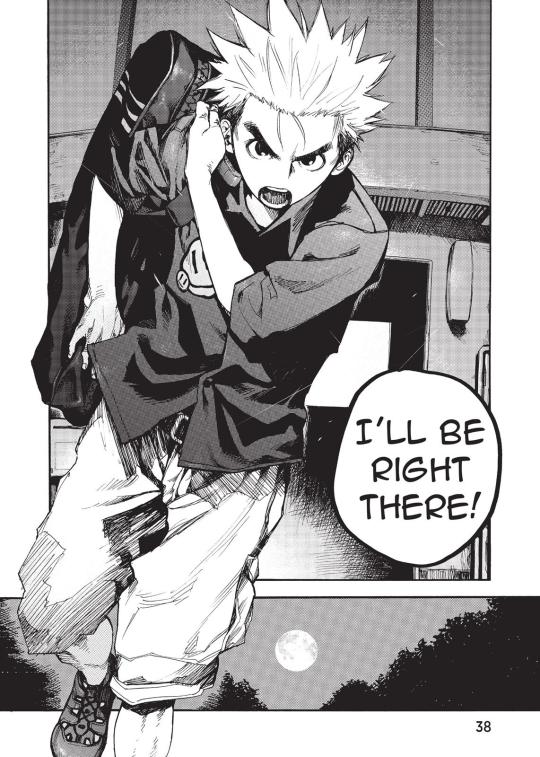

These two pages are both from the first chapter. Note the details on the folds of clothes, the sneakers, the officer's ear, and his uniform even. I have not come across many manga who's art begins with dramatic detail in the most mundane things such as clothing, at least not in such a way. I'm reminded of how in sports manga, the mangakas take a lot of time to detail a player's shoes, because those have importance to the sport itself.
To clarify, Ajin still went through a maturity in its art. Obviously, there was a change when the original writer Tsuina Miura left. With Sakurai having more control over the story, it's clear his change in story affected the characters and art style as well. For example, Kei Nagai goes from a rounder more doe-like appearance to sharper and straighter lines. His original design fit alongside his character portrayal as an innocent kid unfit for the severity of the story's premise; Kei was perhaps meant to be pitied in the original story.
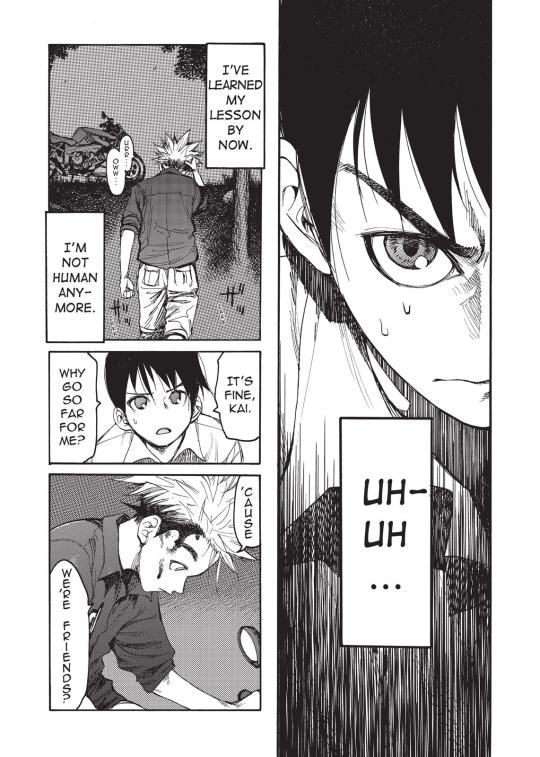
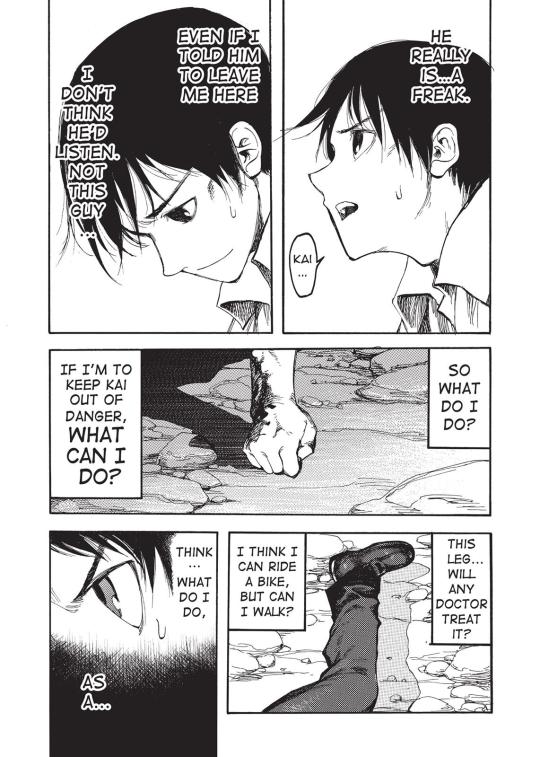
After Sakurai became the writer, Kei changed into an untrustworthy character who could shift personalities, utilizing both the younger look of the first volume, and the more confident and mature appearance Sakurai had created. Sakurai says that after volume 1, he "tried to move the art gradually closer to [his] own style" (ch.83, pg. 82). I recognize Kei's purposeful tonal changes as a creative method to transition the manga into Sakurai's own style and design changes that he had decided for the story.
Below, this series of pages illustrate first the differences between Kei in volume one and two. Then, the ways Sakurai uses both the softer and sharper designs to convey a transition of his character.
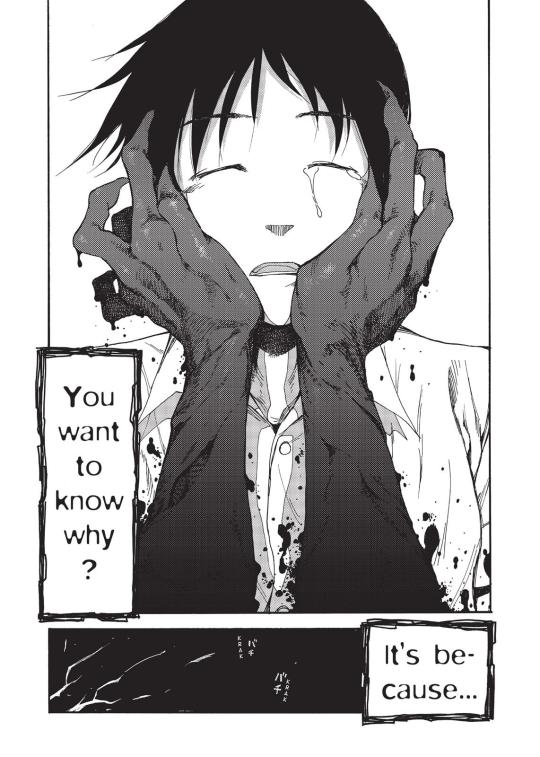

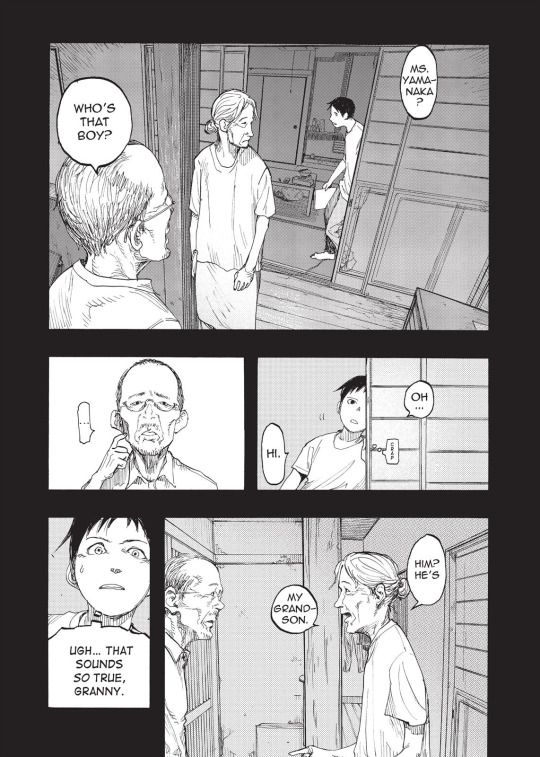
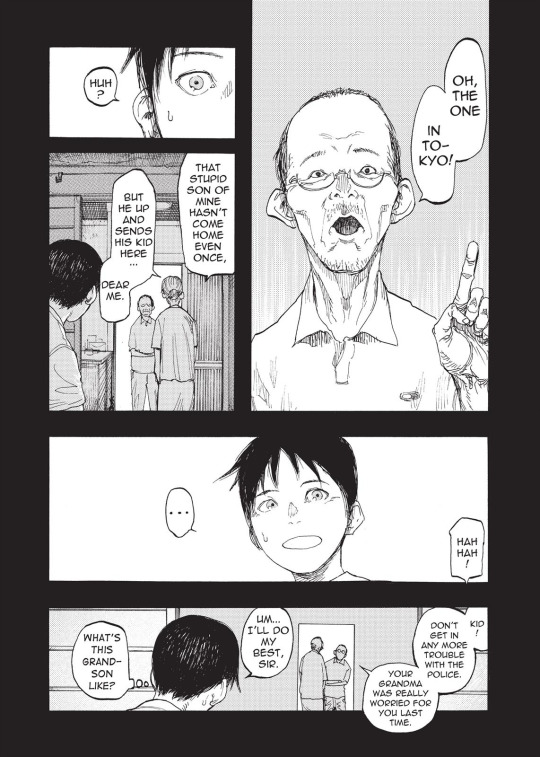
Finally, in chapter seventeen, page seven, Sakurai commits to the shift and reveals this new design and characterization to be the "real" Kei all along. Nakano comes to the same realization as the reader.
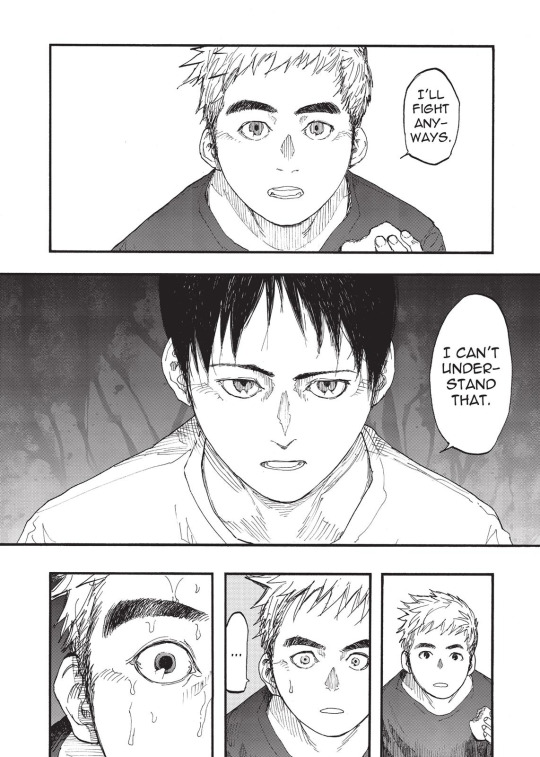
Sakurai used Kei's earlier more pitiful appearance to show Kei's softer mask that he wore to hide his true, more cold and calculative nature. After the moment between Nakano and Kei, the later design remains more consistent and total. Personally, I enjoy the later design more than the first and what it implied for the story. Along with a change in Kei's character was a change to the story's tone as well. Sato became more devious, and so did Kei. These character changes, in a way, foreshadowed the extremes in which the plot would take as well.
Though, still I would have enjoyed the closer relationship that was foreshadowed for Kei and Kai. I mean, look at these pages and tell me you don't see a budding homoerotic romance on the rise!
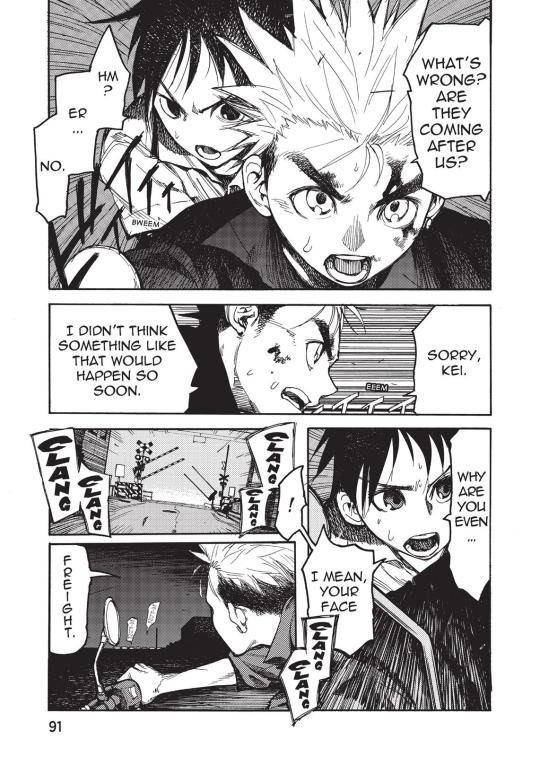

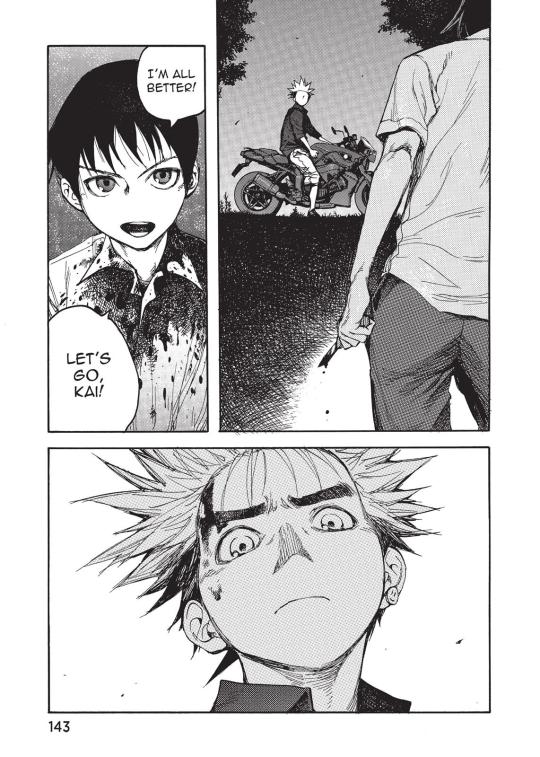
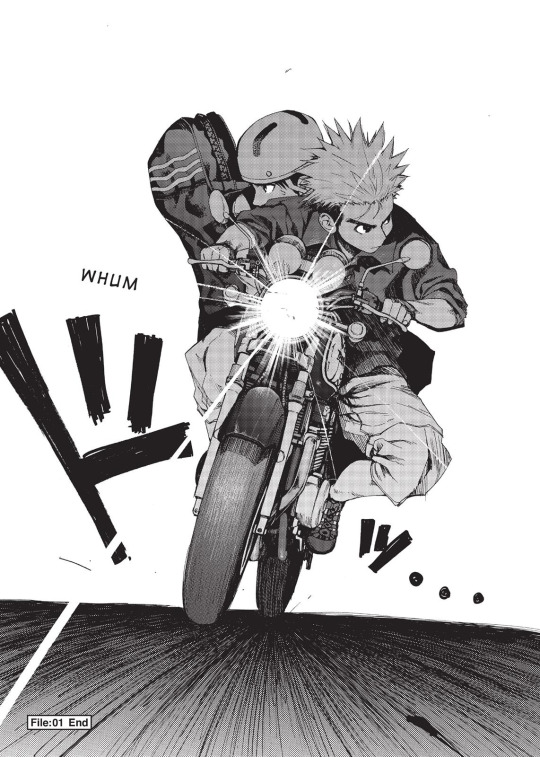
To round out my thoughts, I enjoyed the first premise, but overall enjoyed the second premise even more. In the next review, I'll dissect Sato's character and how he was handled from an authorial point of view. I just needed to discuss the art style change and what it implied for the story, especially Kei, as he plays an important role for the overall tone of the story.
#ajin#ajin demi human#ajin manga#manga#ajin review#manga review#literature review#book review#review#okay yeah#I should make this a youtube video
49 notes
·
View notes
Text
im bored so here's some of my favorite anime soundtracks + a favorite song from them
Parasyte: The Maxim OST – Ken Arai Favorite track: I AM (not an easy choice tho, bc there's so many bangers on that soundtrack... except bliss and next to you, theyre overrated)
youtube
Hellsing OST – Yasushi Ishii Favorite track: Gypsy of Atonement (also not an easy choice, put both these albums on shuffle and i can listen to it the whole days)
youtube
Ajin OST – Yugo Kanno Favorite track: Hunted down
youtube
Mushishi OST – Toshio Masuda Favorite track: Shinen
youtube
Monogatari Series OST – Satoru Kousaki Favorite track: Kizuna
youtube
#ok and thats it bc i suddenly ran out of energy for this post#i was gonna add the detco ost as well but picking a favorite from it seems like too much for rn#long post#kostek original#Youtube#hellsing#parasyte the maxim#mushishi#ajin#monogatari series#kostek reviews
38 notes
·
View notes
Text
Ajin: Demi-Human (Manga) Review

The manga follows the story of Nagai Kei, a highschooler, that comes back to life after dying from being hit by a truck. Through this, he discovered that he's an Ajin, a demi-human incapable of dying. Throughout the story, Nagai Kei will have to evade being captured by the authorities, as well as take down an Ajin terrorist called Satō.
Ajin: Demi-Human dances a fine line between its supernatural and realistic aspects, and yet, the story perfectly balances both. It provides an almost realistic portrayal of what it would be like to have beings that cannot die roam around the earth today. The characters also have their fair share of issues that many may even find relatable.
Gamon Sakurai's art greatly developed throughout the story and it is spectacular, but his art shines the most when depicting expressions. It feels like watching a movie with how expressive the characters look.
Unfortunately, due to the story's focus on the antagonist, many promising characters felt like wasted potential. The whole manga felt rushed near the end because of this.
Regardless of its flaws, Ajin: Demi-Human still delivers the message it intended to deliver. Despite the violence and serious moments, at its core, the story is about having empathy for others. Highly recommended!
I take my life seriously.
6 notes
·
View notes
Text
Kagurabachi Chapter 2 Review: Unbreakable Bonds and Unquenchable Thirst for Revenge
Shiba unties the victim, then he and Chihiro questioned the Yakuza boss about the Hishaku. Apparently, they first emerged four years prior and they engage in “small scale witchcraft.” When the Yakuza boss tries to tell Chihiro what he knows about the Hishaku his head and body explode after branches rip through him. Shiba uses some kind of spell to avoid harm, while saving the victim once…

View On WordPress
#Ajin Demi human manga#Anime Review#Kagura bachi#Kagurabachi#Kagurabachi Chapter 2 Review#Kagurabachi manga#Kunishige Rokuhira#Shonen#Shonen manga
2 notes
·
View notes
Text
#its 1:30am but i found an anime on netflix that i rlly started to like.... (ajin demihuman)#i havent looked at reviews yet but MAL had it at 7.4 which isnt bad and the animation is pretty good for 2016 3d anime im just scared
5 notes
·
View notes
Text
Fonzi M: Yoru Wa Nemureru Kai
youtube
I have, however, both read and seen Ajin in its entirety and if there's a hole in your life for supernatural action political thrillers with sympathetic scum as the leads, you're missing out by not reading/watching it. The opening is dark but keeps a poppy beat, preparing you for the just bleak enough nature of the setting. Also, gaspy singing. Very good.
Song Score: 12/10
0 notes
Text
『
hi! i made this blog to jot down my thoughts and opinions on various mangas and books, especially since I have way too many sitting on my shelves waiting to be read. when it comes to writing reviews on these kinds of things, i often tend to be analytical yet sarcastic. so, if you enjoy humor with a touch of wit, you might just enjoy it here! buuutttt, if you're someone who finds sarcasm mutually exclusive with insensitivity i may not be for you 😭.
this is what i have lined up for us ! :
blood on the tracks (review underway)
goodnight punpun (review underway)
the flowers of evil
goodbye, eri
ajin: demi-human
bibliomania
』

will post soon :)
#anime / manga#shuzo oshimi#chi no wadachi#mangacaps#manga aesthetic#manga panel#seinen#manga review#book review#blood on the tracks#goodnight punpun#goodbye eri#the flowers of evil
4 notes
·
View notes
Note
I must know what mangas you're looking at the reviews for because just by your comments it's still a guessing game. (Which is sad how many times these things have happened but also incredibly funny to watch as an outside party.)
Some of them were: Ajin, Shokugeki no Soma, Soredemo Sekai wa Utsukushii
And the one where the author was arrested is Act Age
#there were others but these were the ones that impacted me the most#ajin's ending was okay but not great apparently#soma had a boring ending and people were just glad it was finally over#soresekai was the most disturbing one and everyone hated where the series was going#answered#jay
0 notes
Text
An Ajin Manga Review: Sato Was Never Defeated
Gamon Sakurai's weakest point in writing Ajin was that Sato was never defeated by Kei, but instead gave up in the end. Sakurai explains Sato as one who allows his sense of entertainment to lead his life. Sakurai demonstrates Sato's need for a stimulating challenge in chapter thirty when he endangers his extremely important rescue mission for the sake of fun.
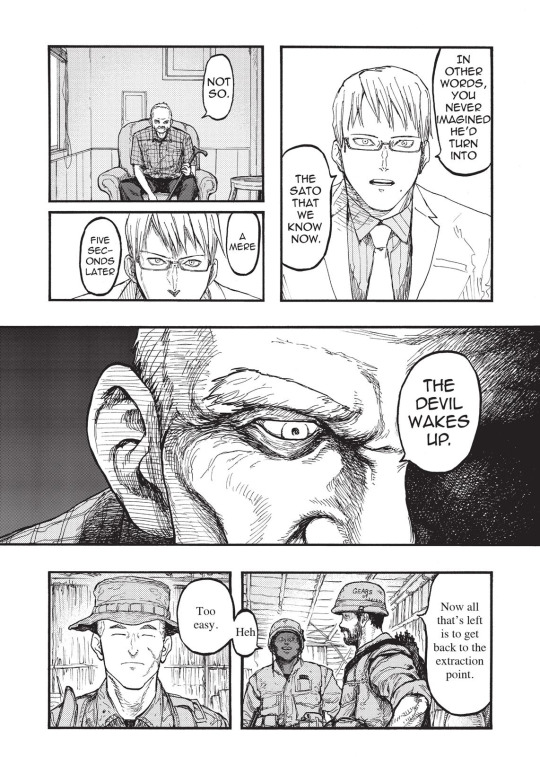
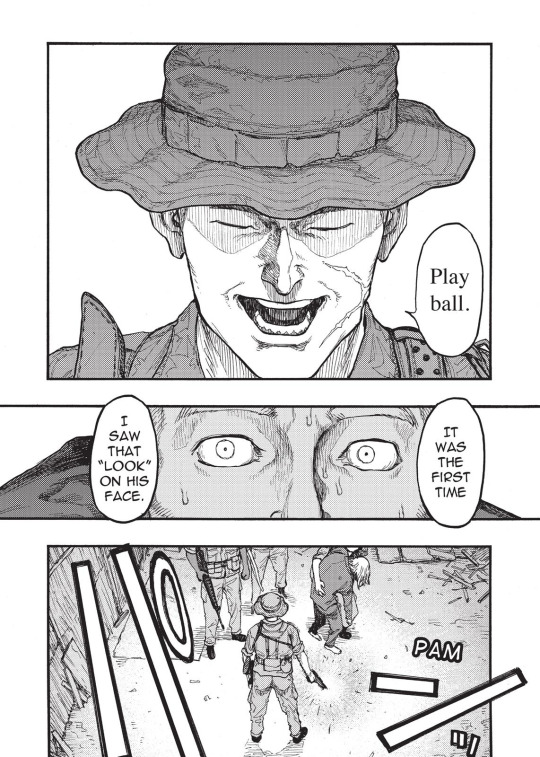

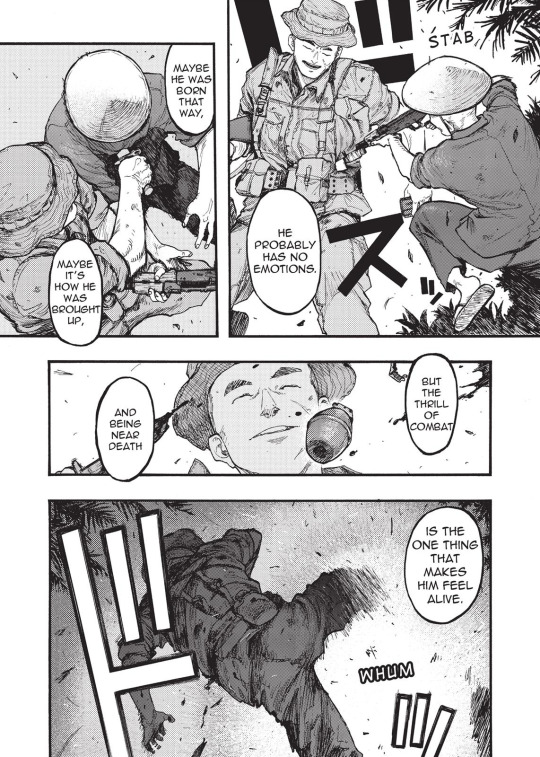
He endangers all of his teammates as well as the rescued prisoner. The stakes that Sakurai has set here, which include multiple lives and Sato's career, encompass the sacrifices Sato will make to entertain himself. As a person, he will readily enter the most dangerous fires if it means he will have fun. Sakurai reiterates my observations with the final pages of chapter thirty, when Sato's dad reprimands him and tells him that life should not be treated as a game, or something trivial and taken lightly.
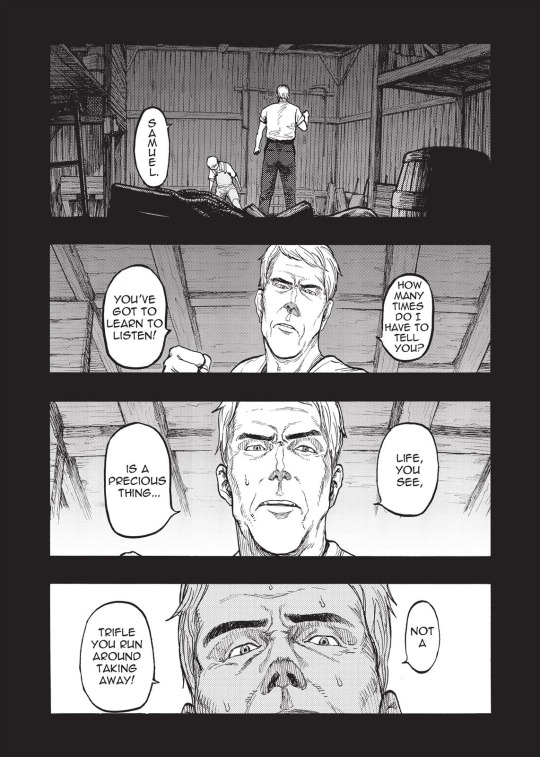
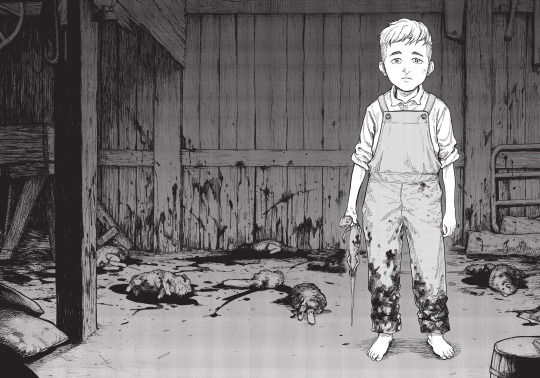
Sato's nature, to see life as a game, and his use of his own and others' to violently entertain himself, leads his motivations throughout the story. I argue that Sato only used the Demi-Human crisis as a conduit for his bloodlust. While such a point seems obvious on the surface, I mean to expel any possibility that he cares even a small bit for Demi-Humans and the growing violence against them. Sato, as a villain, has only one role to play within Ajin: to be the foil of Kei Nagai. Foil here means that both Sato and Kei lack empathy for other people, but they both presents this trait in different ways. Often times, foils are opposite of one another. The narrative focuses around Sakurai's exploration of a moral battle about human empathy. He uses the DH crises as a backdrop of the moral battle occurring between the two. Therefore, I argue that Sakurai uses Sato and Kei Nagai to demonstrate how human rights crises can often be used as covers for battles between powerful individuals' egos.
Throughout the narrative, Sakurai places the general public and the government's focus directly on the Demi-Human humanitarian crisis in Japan. Journalists and political activists argue about the violent extent of anti-DH laws. In online forums, regular people react to the news and viral videos about DHs; some joke, but most refute the idea that DHs face any sort of violence while within government custody. Actual government officials take Sato at face value and argue to ignore Sato's demands and focus on continuing their cruel behavior. The government then aims to more harshly punish and violate DHs in reaction to Sato's crimes and demands.
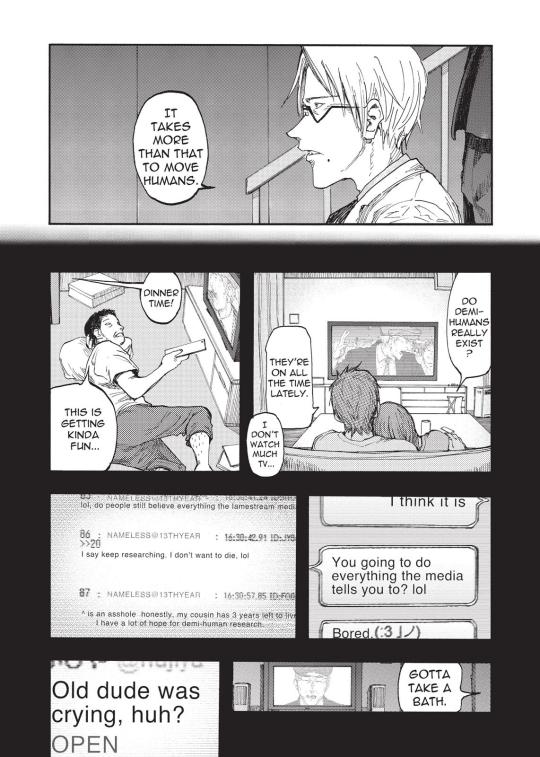
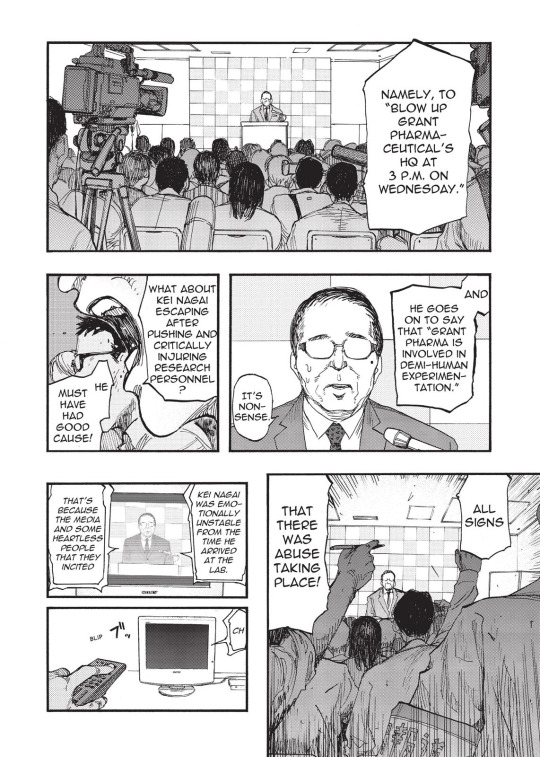
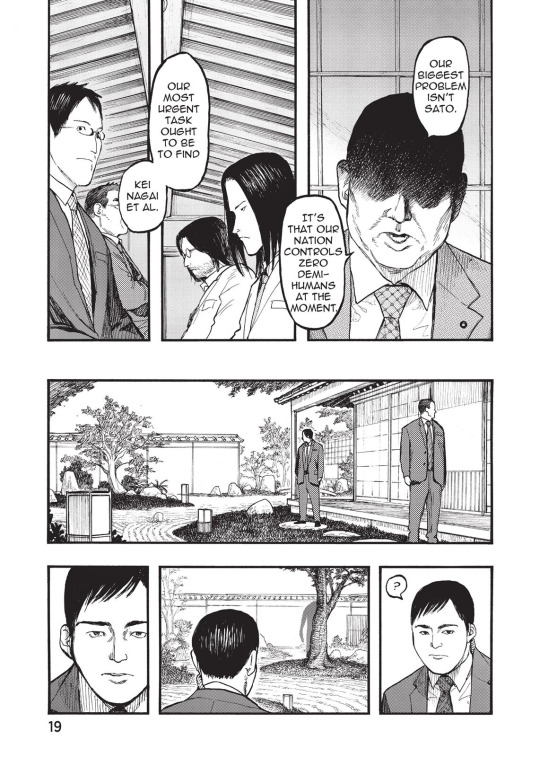
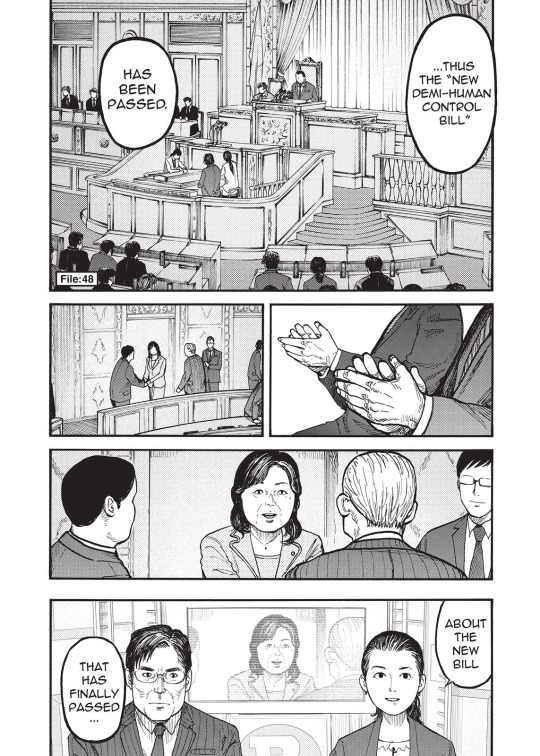
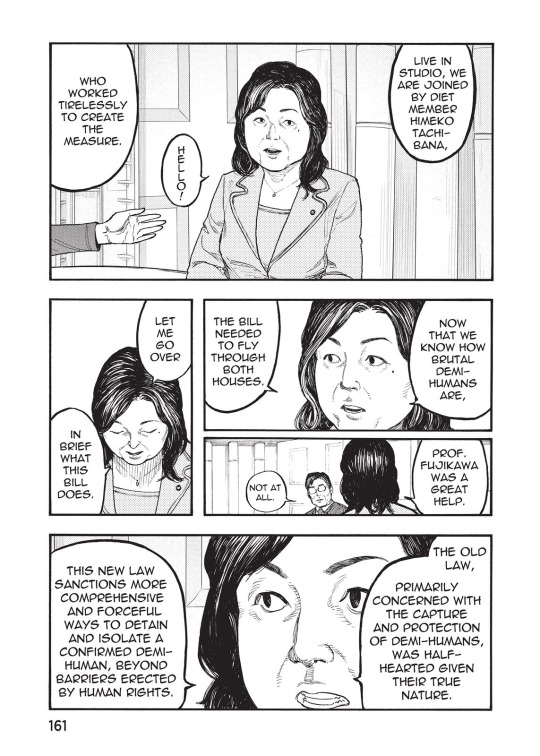
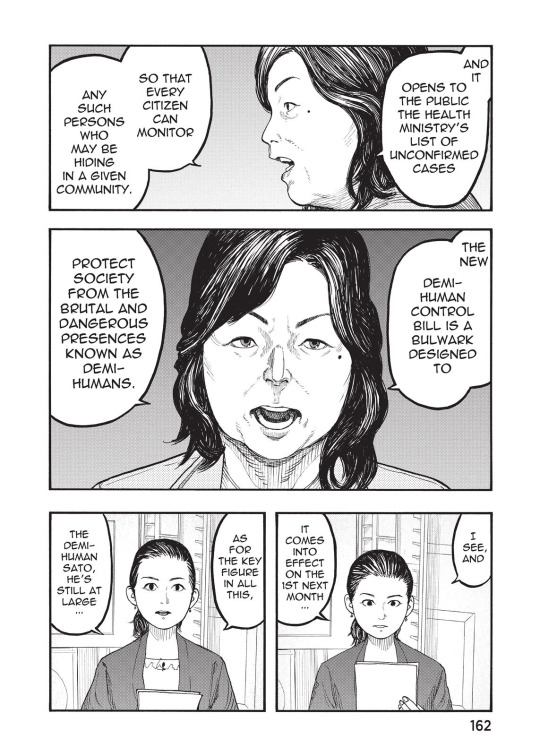
Through pages such as the ones provided, Sakurai demonstrates that Sato nor Kei act as the government and public's main concerns. Instead, Sato nearly single-handedly fuels Japan's arguments and attitudes about the DHs. Sato's claims of the government torturing DHs, his terrorist attacks, and his online uploads only inspire Japan to focus on DHs, not himself, as a subject of discussion. The discourse hinges on the questions: what does Japan do about the DHs?; are they allowed to live fulfilling lives?; should the government more viciously hunt DHs down? Sakurai depicts a Japan that says yes. The DH Control Bill represents an oppressive government's readiness to punish all those who they feel do not belong in their society. Sakurai also heavily criticizes governments' ties to corporations and the greed that prospers between these institutions. While the government denies that DHs were ever tortured, they also expeditiously pass laws that punish any and all DHs in reaction to one person's terrorism.
Despite his blatant commentary on the ways a society can trample on the human rights of oppressed groups, Sakurai focuses Ajin's narrative on Sato and Kei more than anything. All the details expressed above occur in the background of the narrative.
Japan denies that a DH human rights violation has occurred, while simultaneously denying DHs humanism. Throughout the narrative, the government takes egregious actions against DHs. Sakurai rarely shows any DHs beyond the main cast that suffer from these laws. Kei’s death in the first volume and Izumi’s backstory does show the reader the public’s general knowledge that DHs can be turned in for a ransom. Yet, beyond Izumi and Kei, Sakurai does not depict any other DHs fleeing or suffering from the violent laws being passed in the background of the narrative.
Sakurai has no need to show any background stories of DHs suffering. The story focuses on the battle between Sato and Kei most of all. Each story arc revolves around conflict between Sato and Kei. Every other character involved may be seen as simply being collateral damage in the battle between the two of them. Sakurai does not need to depict any other DHs suffering from the aggressive and violent laws made to oppress them, because that's not the point. Sakurai purposely depicts a society caught in the midst of an ego battle between two people. Chapter thirty-one begins with a neat illustration of my argument. The DH rights crisis appears in the literal middle of illustrations of Kei and Sato's battle of egos.
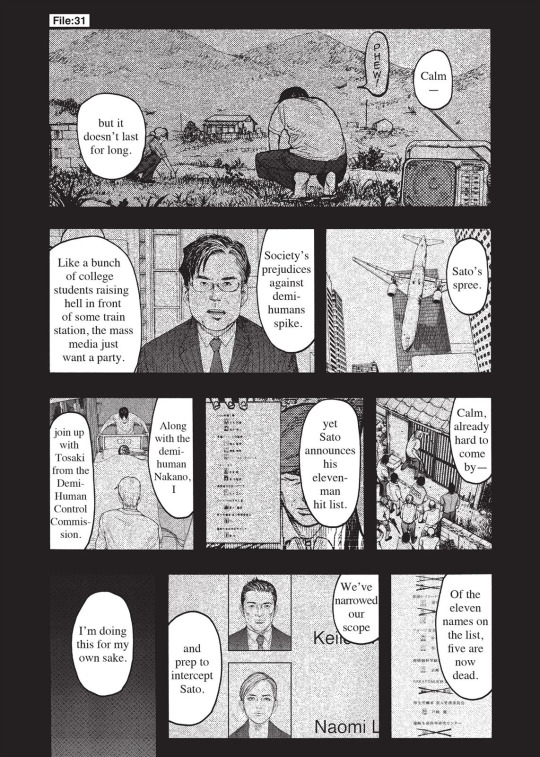
Sato's terrorist attacks act as nothing more than extensions of his own ego. As argued above, Sato does not care even a little about DH rights. He uses the DH humanitarian issue as a catalyst to fuel his need for bloody entertainment. Sakurai overtly depicts Sato as a character with no regard to the importance of life at any capacity.
Sato's bloodthirst and role as an aggravator for a humanitarian crises sets him up to be a morally bankrupt symbol of militaristic power. He pretends to act in the interest of an oppressed minority group while actually only satisfying his bloodlust. Sato's defeat therefore represents a victory in favor of the defense of life and its importance. Also, an expulsion of false actors in the fight for oppressed peoples' freedom from oppressive governments. More on the implications of Sakurai's ending later.
Sakurai uses Kei to depict his idea of what a struggle between an emotional and purely "rational/logical" perspective of the world looks like. I place rational and logical in quotations because even in-narrative, this terms takes on different meanings. At one point, a rational decision means acting in one's most favorable odds of success. In another moment, Kei breaks this rule and declares it to mean acting in a way to gain more favorable odds for one's goals. Instead, I will refer to the "logical" side of Kei as lacking empathy, because that's what Kei's attitude actually demonstrates.
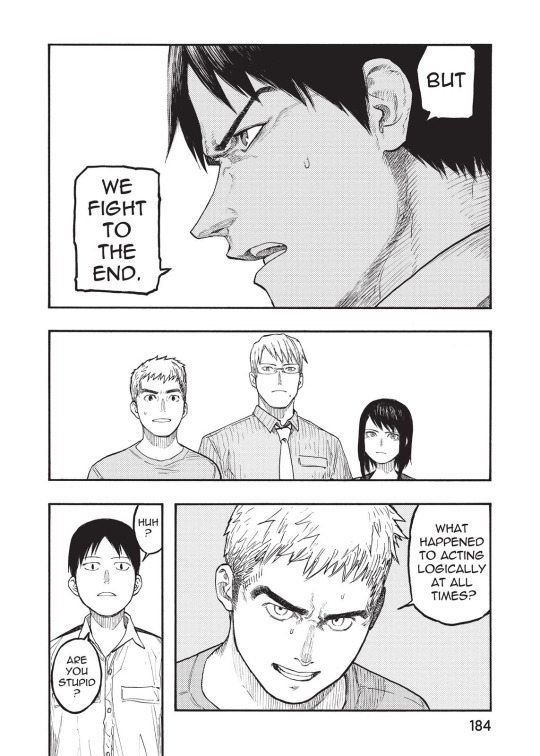
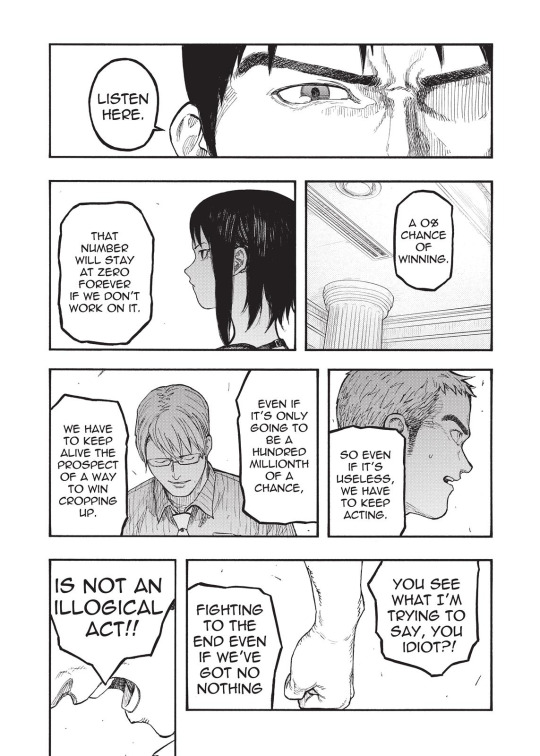

Kei wants to be cold and distant. He feels life would be easier if he could be aloof and above any emotional issues that naturally occur in relationships with other people. He pretends to be above emotional responses to other's pain. In a way, Nakano acts as Kei's foil just as much as Sato. If Sato represents Kei's inability to completely detach himself from his natural empathy, Nakano represents Kei's inability to fully tap into his those feelings. While Kei lacks empathy, he does not see life as a game like Sato does. Kei still believes in an inherent value in life or being alive. Kei still goes out of his way to help others, even when it inconveniences him and his plans. For example, Kei returns to save the grandma who he stayed with, even though he was ready to escape with Nakano and leave the countryside behind. He refuses to explain his actions to Nakano, or even show himself to the grandma, revealing the selfness nature that he shares with Nakano.
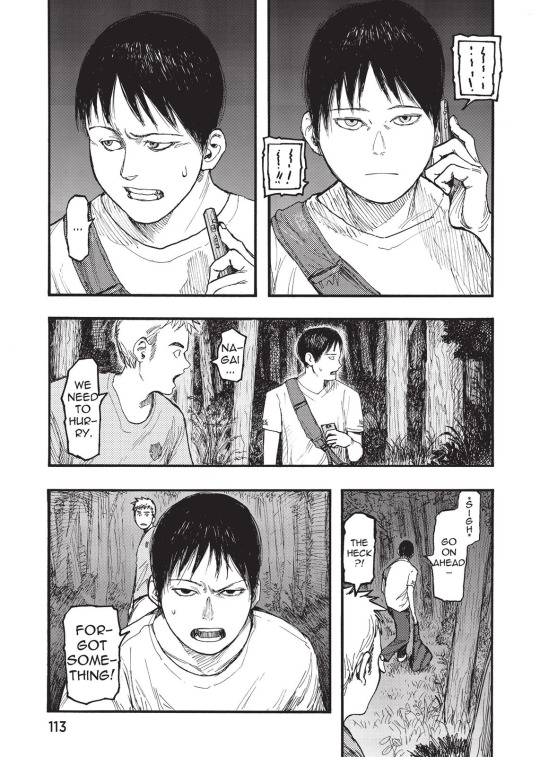


Nakano consistently commits to selfless acts in the name of simply helping people. He expects nothing in return for his deeds, nor does he ever express a desire to be seen as a hero. Nakano cries for the sake of the others who have died, and who will die, declaring that he will always give his life to those who need him, no matter what.
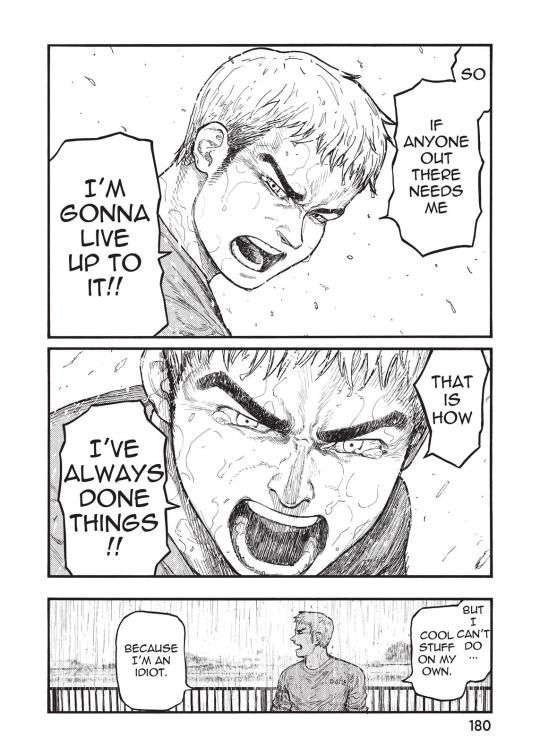
Nakano represents Sakurai's idea of an extreme empathy for other people. He seriously considered Sato's proposal to improve the lives of other DHs, and once that was proven false, he committed himself to stopping Sato's terrorism, exemplifying his highly empathetic nature for other humans. Kei rests at the center of extremes that Sato and Nakano represent. Sakurai uses Kei's mother to demonstrate Kei's personal conflict between a cold demeaner and empathetic reasonings. In the second panel in page twenty-eight, Kei's mother even directly rebuffs Nakano's desire to care for everyone. Sakurai purposely places Kei in the middle of Sato and Nakano's empathetic extremes.
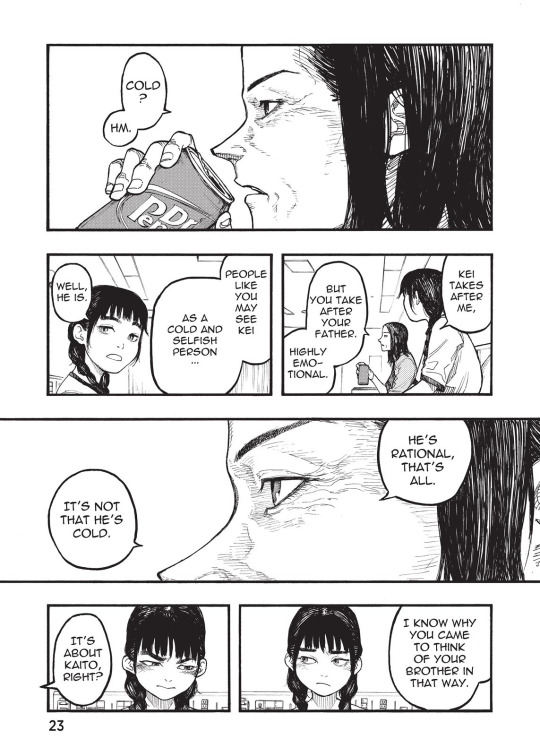

Instead of focusing on Kei as Sakurai's exploration of a balanced moral code, I want to shift focus back to Sato's end. I have thus far agued that Sato never cared about any other DH while he committed terrorist attacks. To reiterate my argument, I have shown evidence that Sakurai's depiction of the DH humanitarian issue plays a background role, while Ajin's narrative instead focuses on the battle between Sato and Kei. Sato's attacks only end on one condition: once he gets bored. He does not complete the hit list because he gets bored of it, same with the suicide plane attacks in the last arc. His motivations center around his need for violent entertainment, which Kei's challenges stimulate. In the end, when Sato is stopped, it's only after he's done doing everything he wants. Essentially, Sato does not lose, he simply satisfies himself. He reaches game over of his terrorist attack speedrun.
Sato's self-inflicted game over does not meet the stakes Sakurai set for Sato as a villain. As I argued above, Sato's defeat represented a victory in favor of the defense of life, and an expulsion of false actors in the fight for oppressed minorities against oppressive governments.
Given that Sato represents the worst of humanity, a powerful being with zero empathy for others, I find it distasteful for him to be allowed to commit egregious acts of terrorism on a whim and hardly suffer any consequences. Sato's unconscious body only receives an indefinite prison sentence. Because Kei simply knocked him out, Sakurai alleviates Sato of having to directly face any moral judgements from other characters. The rest of the cast do not get to voice their grievances directly to him. Honestly, it's not like he would care one way or another anyway. Sato reads to me as a power fantasy character. Not to say that he's Sakurai's power fantasy, or a projection. Just that he fits the model of one (extremely capable and undefeatable). Sato doesn't care about laws or consequences of his actions, and instead solely cares about his own entertainment. Not his own well-being, or anyone else's.
Sato allowed Kei to rush him into the river and possibly knock him unconscious. In the end, it was his decision to be caught. He was never defeated. He simply gave Kei the chance to win on the foundation of a desperate wager.
What does it mean for Sakurai to create a story in which the morally bankrupt type of human never loses? Ajin depicts a small group of humans attempting to save Japan from a crazed terrorist desperate to make the entire country his bloody playground. Sato spits in the face of people who genuinely care about the DH crises around the world. Sakurai criticizes Japanese media and government as immoral and corrupt institutions throughout the entire story. Finally, he depicts their violent murders at Sato's hands.
I do not have any extreme take to attach Sato's non-defeat too, and I won't make any wild arguments about Sakurai's politics considering the unserious and exaggerated tone of Ajin. But I will say that as a reader, Sato's non-defeat weakened the story for me. Sato's ending weakens every other character's, especially Kei's. They appear to me as people who luckily maintained some semblance of dignity instead of triumphant warriors who took down a morally bankrupt mastermind who unnecessarily endangered a minority group of humans.
I enjoyed Ajin, but I would not read it again. I personally do not find enjoyment rooting for Sato, but instead against him. When the stakes for his death were so thoroughly raised, Sakurai's decision for Sato to never actually be defeated spoiled those expectations I had for a narrative about the importance of human empathy.
Officially, I give Ajin a 6/10. Hope you enjoyed reading!
#ajin#ajin review#ajin manga#ajin demi human#kei nagai#sato ajin#ko nakano#izumi shimomura#literature review#manga review#gamon sakurai#review
29 notes
·
View notes
Text
two things i appreciate the most about ajin anime:
absolute banger of a soundtrack
the delightful way they animated body language
#two things aside from the fact its an adaptation of ajin manga which i love ofc#kostek original#seriously the animation may not always work with the art style (especially in the face) but they really had the movement down#kostek reviews
4 notes
·
View notes
Text
Ajin Series Review
Ajin was a fun little ride - what did you think?
Anime that have come out on Netflix have been very hit and miss for me. So when I first saw reviews for Ajin while I was curious, I didn’t rush into viewing it. When I finally did watch it, I very much enjoyed it, after I got over the visual style. I’m going to be honest, the character animation is creepy and while that works for the Ajin and villainous characters, even the human characters are…

View On WordPress
2 notes
·
View notes
Text
Ajin: Demi-human (season 1) Review
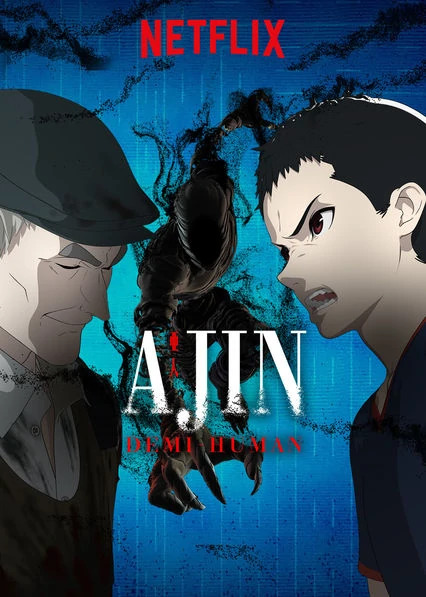
THIS REVIEW WILL CONTAIN SPOILERS
Oh my goodness was this a slog to get through, Three days people, it took me three days to get through 13 episodes Because OMG Setting aside the fact this is some of the ugliest 2d to 3d rig work I have ever seen, I have never seen a show have some much going on with out achieving anything. Ok ok ok let me start this properly.
In the world there are being known as Ajin, these Demi-human beings are rare with only three known cases in Japan, the Ajin are capable of resurrecting from fatal wounds making them Semi-immortal, they also have the ability to summon being known as ‘black ghosts’ which can be used for all sorts of things. There is unfortunately no way of knowing if a person is an Aijin until they suffer some for of mortal injury at that point their body will regenerate and they will live this is the case for Kei Nagai, a high school student studying to be a doctor. While the government of Japan have led people to believe that Ajin are kept in protective custody it is learned that not only are they but most other countries use Aijin as test subjects for medicines and weapons, including life fire testing, because of their regenerative abilities.
Story time
17 years ago during a war in an unnamed African nation the first Ajin was discovered. Reffered to as a soldier of god because he could not be killed the soldier was immobilized and claimed as property of the US government.
Now Kei Nagai is an apathetic highschool student studying to be a doctor on his mothers demand. While to his ‘friends’ he seems like a cheerful if easily taken advantage of boy the truth is he is apathetic and cut off from the people around him seeing only the value they have to him personally. While walking to school he and his friends note another boy their age Kaito sitting outside a convenience store they comment on how weird he is and question if Kei is his friend after Kaito waves to him, Kei denies this and they walk on.
At school the subject of Ajins is brought up because of their value in the medical feild, one of Keis friends shows another classmate a video of Inhumane testing on an Ajin subject. The boy also asks his teacher if the truth about the high reward for an Ajins capture is true. For some reason this startles Kei and his reaction draws attention so he asks if Ajin aren’t really human. His teacher says they are not.
Reminiscing he vaguely remembered the death of a childhood pet, after burying it while trying to console his sister he wonders about death and witness’ something strange. curious about the memory he decides to visit his sister in the hospital and tries to ask her about what she remebers but she refuses to discuss it being outright hostile to him.
still lost in thought and wondering about Ajin as well as flicking through Study cards Kei misses the stop light and begins to cross the street before being hit full on by a truck. the truck drags his body quiet a ways as it skids to a halt and his friends are horrified by what they’ve witnessed, the driver is shaken and climbs out desperate to say that it was Keis fault when to their shock Kei crawls out from under the truck dazed t first he is confused about what happened before quickly realizing and becoming upset he insists he’s human and begs for his friends to believe him however he realizes they only see him as a way to make money by turning him in. in terror Kei screams unintentinally releasing his voice, another unique trait of Ajin that causes a temporary paralasis in those who hear it, before fleeing the scene.
a little later Yu Tosaki and his body guard and assistant Izumi Shimomura of the Ajin control branch of the government arrive to question Keis friends and his mother. As this is going on it is revealed that Kei has fled to a local Shrine and then into the woods beyond, desperatly thinking who might help him he remebers Kaito who had been a childhood friend but whome he’d been told not to be around anymore by his mother. Desperate and worried Kai Might also want to turn him in but feeling alone Kei calls Kaito and the other boy is ready to help his friend filling a duffle bag with supplies and heading out, knocking out a poliece officer who had found Kei Kaito offers his old friend a hand up and they flee the area on a motorcycle.
The Bad
Despite how much I’ve written that happened in the first episode. it not actually a lot. theres a lot of nothing in this show and thats a major problem. I a not against quiet moments, for example Hiyao Miyazaki is very well know for his long silent scenes, but even these scenes serve to tell story in one way or another, I get the feeling either the writer or director of this show wants to emulate that but the quiet scene in the show just don’t accomplish anything. theres also a sense of ‘artistic padding’ where things are added for the art of it, I don’t know if someone in the production team had higher aspirations or if they where just desperate to cover the ugly modles but it doesn’t work.
The episodes feel long but almost nothing happens. or a lot happens but none of it matters or is memorable. The motivations of the antagonist make no sense, and while I have a theory of who he truely is I won’t say untill I do my reviw on season 2 (Which won’t be for a while because this was so hard to sit through)
Kei himself is a terrible protagonist, there are moment whre you think he’ll get better, but he really doesn’t in fact I thought the show was going to pull some kind of switch and make the story focus on the friend Kaito who seems to really genuinely still care about Kei even though they hadn’t been friends for years and who insists even if Kei is an Ajin, he’s still Kaitos friend so that’s all that matters. But Kei leavs Kaito after only a couple episodes
It’s clear that there is something not right with kei from the get go, the first time we see his phone all his friend are listed not by name but number literally ‘friend 1′ ‘friend 2′ and so on, and as the show goes on theres an impression that the creators where trying to make Kei a Psychopath. I’m not talking Ax wielding movie psycho but a clinical psychopath, no empathy no connection to the people around him, a general callous nature and his willingness to use then abandon anyone who might have value. I’m not a fan of using mental illness as a way of making people ‘other’ mental illness is demonized enough, and frankly it’s hard to empathize with a protagonist who openly admits they don’t care about anyone.
There aren’t any real stand out characters either, they all feel like cut outs, you have you deceptively friendly antagonist, you have your to serious government agent, and his body guard who obviously has a crush on him, you have the best friend, you have the friendly granny.
It’s just all been done before and better.
Now about episode 8 a character name Ko Nakano is introduced and for a moment I thought Oh the shows just going to give us a new protagonist... NOPE! he get capture by Kei who keeps him locked in an old shipping truck for the rest of the season, Fuck that noise. honestly Kei gets less and less likeable as the show goes on. He abjectly refuses to get involved with trying to stop the antagonist, Sato’s, terrorist plot even saying openly he doesn’t care what happens to other because he’s found a nice place where he can live a quiet normal life. Kei had in fact been taken in by a kindly older woman who convinced the villagers kei was her grandson from tokyo who had gotten into trouble and was staying with her.
That being said.... There’s a couple good things
The elderly woman is quiet charming, she doesn’t care about the Ajin or what ever other trouble Kei seems to be in she just sees a young man who helped her after she fell and lets him stay. If not for another villager recognizing his picture on the news and reporting him to claim the rumoured reward Kei clearly would have been happy to stay in that little village forever and just live a quiet life.
The opening theme song is pretty good. the CG is frustrating in that in the opening they show shots of characters as they looked in the manga and those drawings are amazing, This would have looked so much better 2d Animated.
The black ghosts are kind of neat.
theres a couple interesting fights with the Ajin, since they recover almost instantly from death they’ll actually kill themselves in combat to resurrect with out their injuries or to even escape grapple or escape the effects of tranquillizers, so that’s neat
I haven’t got much here guys I’m sorry I’m trying but this just, I feel like there might have been something good under all the thick thick thick padding.
Final Thoughts?
I don’t recommend it, even for one watch it’s just a slog, it’s not enjoyable it’s not even a good time killer because it feels like it drags.
Everything from plot point to characters to scene have been done before in better shows, and the aesthetic is just Ugly, terrible CG modles with awkward round movements to avoid collision issues clearly, and the backgrounds look like someone took photos and then put them through the photoshop watercolor filter.
There’s nothing worth reccomending about it, I know Netflix has stuff way better then this so go watch that because this so Not worth your time.
#anime#anime review#Netflix#netflix review#Ajin#ajin demihuman#ajin demi-human#reveiw#So not worth it
5 notes
·
View notes
Text

AJIN – GAMON SAKURAI ➡ ig: @bookandmanga
.
“Cậu nghĩ tất cả sinh mạng đều có giá trị như nhau ư? Nếu gia đình cậu gặp nguy hiểm tới tính mạng, cậu nhất định sẽ cứu họ. Nhưng nếu nhìn thấy tin tức về việc hàng triệu người chết ở quốc gia nào đó thì cậu cũng chỉ cảm thấy chút thương xót thôi, đúng chứ? Tất cả con người trong vô thức đều luôn "cân đo" giá trị sinh mạng của người khác. Cậu cũng thế thôi. Đừng có mà chỉ trích tôi chỉ vì tôi đang l��m điều đó một cách có ý thức!“
.
Ajin là một dạng người bất tử, kiểu gì cũng không thể chết được. Vậy nên khi mà con người bắt được một Ajin, họ sẽ thí nghiệm, cắt chân, cắt tay, cắt thanh quản,… Nhiều Ajin đã phải lẫn trốn. Có những Ajin thậm chí còn không biết mình là Ajin, cho đến khi họ chết lần đầu tiên.
Và sống dậy.
Nagai Kei bị phát hiện là Ajin khi cậu đột nhiên sống dậy trong một vụ tai nạn. Cậu phải chạy trốn, mất đi cuộc sống yên bình thường ngày của mình. Rồi cuối cùng cậu lại bị kéo vào âm mưu nổi dậy của các Ajin: Khủng bố để đòi lại quyền bình đẳng.
Nhưng mà, Ajin thì cũng có Ajin this Ajin that. Việc khủng bố chỉ chứng tỏ năng lực kinh khủng khiến mọi người khiếp sợ của Ajin, vì vậy Nagai hoàn toàn không có cơ hội trở về với cuộc sống của mình. Không còn cách khác, cậu phải đứng lên hợp tác với kẻ thù, chống lại chính chủng loại của mình.
Bộ này lúc trước mình có xem qua anime rồi. Anime thì làm theo kiểu 3D, xem thì hơi weird nhưng mà riết cũng quen. Ajin đúng kiểu hành động, đánh nhau, máu me thấy ghê, nên coi bao đã. Vừa rồi ra mắt manga nên mình phải mua ngay. Mà mua xong mình cứ để đó thôi, đến khi hứng lên thì lôi cả đống ra đọc luôn một lần cái ghiền chịu không nổi. Không chỉ có giết chóc mà nó còn thông minh một cách rùng mình.
Kiểu như, bạn có thể hồi sinh từ một phần cơ thể to nhất, nên bạn có thể cắt bàn tay mình rồi vứt một chỗ thật xa, sau đấy xay toàn bộ cơ thể (như xay sinh tố á) là từ cái bàn tay bạn vừa đem đi chuyển phát tới nơi cần tới, nó sẽ hồi sinh c�� thể bạn ngay tại nơi đó luôn. Thấy chưa, đỡ tốn tiền đi Grab, tốn tiền ship cái tay thoi lol.
Con người thì chắc chắn lúc nào cũng sẽ biến chúng ta thành một trong hai kiểu: từ người tốt trở thành kẻ xấu và từ kẻ xấu trở thành người tốt. Kẻ thù có thể đột nhiên trở thành đồng đội, và đặc biệt hơn lại là một con át chủ bài. Tuy ai cũng có một mục đích riêng để hướng tới, Nagai thì có vẻ chỉ lo cho bản thân mình, nhưng khi người dân trong làng nơi mà cậu đang ẩn nấp phát hiện cậu chính là Ajin đang bị truy lùng, cậu tất nhiên bỏ chạy, nhưng cuối cùng lại quay lại chỉ vì họ đã bắt bà lão đã cho cậu nơi trú ẩn.
Manga vẽ rất chi tiết, bìa rời ngầu khỏi nói. Cứ hay thì khỏi cần bàn đến giá tiền nhen ;) Truyện gắn mác 18+ vì khá là bạo lực và máu me nhưng mà who cares.
#ajin manga#ajin kei#ajin demi human#nagai kei#mangaholic#anime#mangareader#manga review#review#vietnamese
5 notes
·
View notes
Note
So what are some of your favorite animes then?
Inuyasha is the first anime I sat down for. I used to download episodes with Limewire and watch them for days on end.Pokémon I never watched when I was little, but I picked up the show and really like the Indigo League so far. There’s some honestly good comedy in there, and I love how rude our dub is. I recall James calling some woman a bitch.Inu x Boku SS is filled with anime clichés and the male lead sounds like he’s ripped straight from some horny teenager’s fanfiction, but I bought this shit on DVD, so there.Kuroko’s Basketballmakes basketball tournaments look like superhero battles. The rival kids act like evil movie villains, but if you keep yourself from realizing how pathetically obsessed these high schoolers are with the sport, the anime is really cool.The Disastrous Life of Saiki K.is fast paced and never fails to make me laugh. It’s a comedic masterpiece, I’ve watched it twice.Skip Beat! follows the life of an average girl who manages to become a top class actor, fuelled by hatred alone. Not everything makes sense and the ending is abrupt, but what it does, it does well.One Punch Manis delightfully self-aware, and at the same time takes its world seriously and tells a real story. Like Saiki K, a fun ride to sit through.Mob Psycho 100is similar to One Punch Man, just not as funny. Still awesome.Fullmetal Alchemist, the original series, I only recently checked out. Gud drama, gud jokes. Didn’t like the rebooted series, though.Gakuen Handsomeis a funny parody of Deviantart and yaoi animes, on a budget of 2 cents and used straws.Aho-Girl is sometimes more annoying than funny, but alot of its jokes hit really well. Just like the male lead does the girl.My Love Story!! is cute and surprisingly innocent for an anime.Yuri!!! on Icemade figure skating enjoyable for everyone, though I find the relationship between the skater and his trainer not that romantic/great. Outside of the ring, the dude seems annoyed with his teacher and neither men have other shared interests or traits that charm each other.Little Witch Academiais a fun adventure series based on the movie. It’s about A FILTHY MUGGLE wanting to become a witch.AJIN: Demi-Humanhas terrible 3D animation that moves 5 frames per second, but makes up for it by having an awesome story and interesting concepts.
#anime#review#inuyasha#inu x boku ss#kuroko's basketball#the disasterous life of saiki k#skip beat#one punch man#mob psycho 100#fullmetal alchemist#gakuen handsome#aho-girl#my love story#yuri on ice#little witch academia#ajin#pokémon
44 notes
·
View notes
Text
Ajin
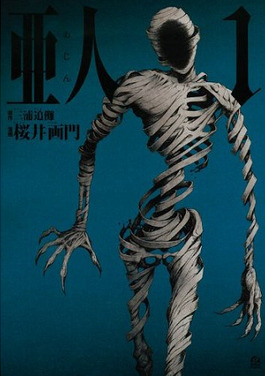
Genres:
Action, Supernatural, Thriller
Content Warnings:
Gore, self-harm, suicide
Average Rating: 7.97
Synopsis:
Seventeen years ago, mysterious immortal soldiers known as "divine warriors" appeared on the battlefields of Africa. These life forms later became known as "Ajin," or demi-humans, and were considered to be one of the greatest discoveries of mankind. The government declared their existence to be compatible with humans; however, it is rumored that they instead offer bounties for captured Ajin to secretly perform inhumane experiments on these rare beings.
Kei Nagai, an apathetic high school student, is studying to become a doctor and only wishes to live a normal life. However, this simple dream is shattered after he suddenly gets into a deadly traffic accident. Reviving at the scene, he is immediately labeled as an Ajin by bounty-hungry witnesses. Unable to understand his immortality or prove his innocence, he starts to live his life on the run and fights for survival. He barely escapes the government's reach when a group of anarchistic Ajin contacts Kei, asking him to join their forces to retaliate against the government. But who is Kei's real enemy, and which side will he take when it comes down to humans versus Ajin?
My Rating: 7
My Opinion:
Is this a deep and thought provoking story about immortality? No.
Is it a really damn fun popcorn read with some clever uses of the immortality gimmick? Absolutely.
I’m usually not one for action stories. It is just not really my thing and I often get bored by it really quickly. Ajin however does a really good job of making you enjoy the action scenes even if you aren’t a big action fan. Reading the manga feels so fluid as if you were watching a movie, thanks to the really well done paneling and layout of the pages.
I’d actually highly recommend that you read it physically if that is something you can afford and are interested in. That is how I read most of it and the few times I read it digitally the paneling didn’t have quite the same effect as when you read it physically.
The action also never outstayed its welcome and has a good amount of breathing moments in between that don’t last too long either.
The characters are also pretty fun and serve their role in the narrative pretty well, even if they aren’t the most interesting characters ever.
Recommended to:
People who want a fun, easily digestible, quickly paced popcorn read that keeps them engaged in the action. If you are a big fan of action in general, go for Ajin. An action hater like me liking it should be enough of a rec to those who actually do like action and gore.
0 notes
Text
Ajin: Demi-Human
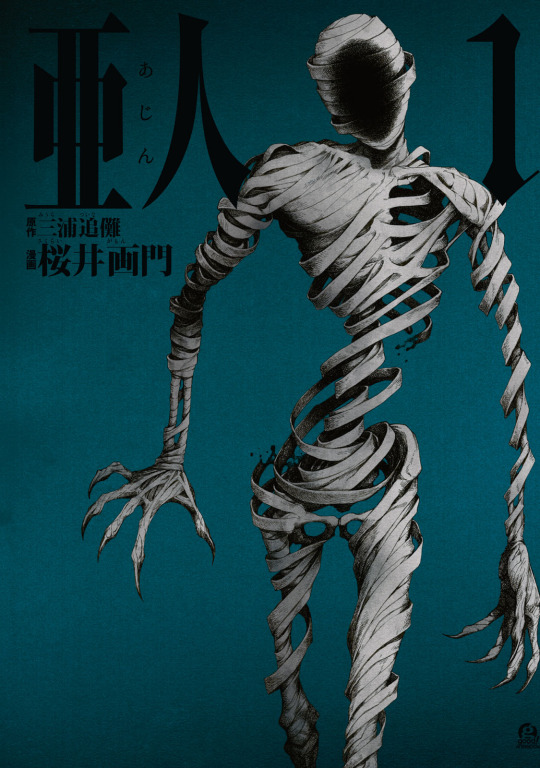
Alt: Ajin
Art: 7/10 Story: 9/10 Characters: 8/10
Genres: action, fantasy.
Ajin follows Nagai Kei, a regular human who discovers he’s an “Ajin” after surviving a fatal accident. This causes a host of issues, as he’s hunted down to be experimented on due to the fantasy-like abilities Ajin possess.
I really liked this manga. I started it twice, because on my first read I gave it up as a cliché action survival manga, but I’m glad I went back to it because it ended up being so much more than that. While it does have a lot of action survival, the true beauty of Ajin lies in the clash between Kei and the main villain, Satou, as they’re both strategists that play well off each other. The mind games in this manga are brilliant and the plot twists had me on the edge of my seat more often than not. For fans of Death Note, I think Ajin would be right up your alley.
It’s also one of those mangas where the art improves as you read. As of the time it ended i would have rated it a solid 8.
Similar manga:
Can You Just Die, My Darling? (Alt title: Konya wa Tsuki ga Kirei desu ga, Toriaezu Shine)
#ajin: demi human#ajin#can you just die my darling#konya wa tsuki ga kirei desu ga toriaezu shi ne#raven's reviews
0 notes